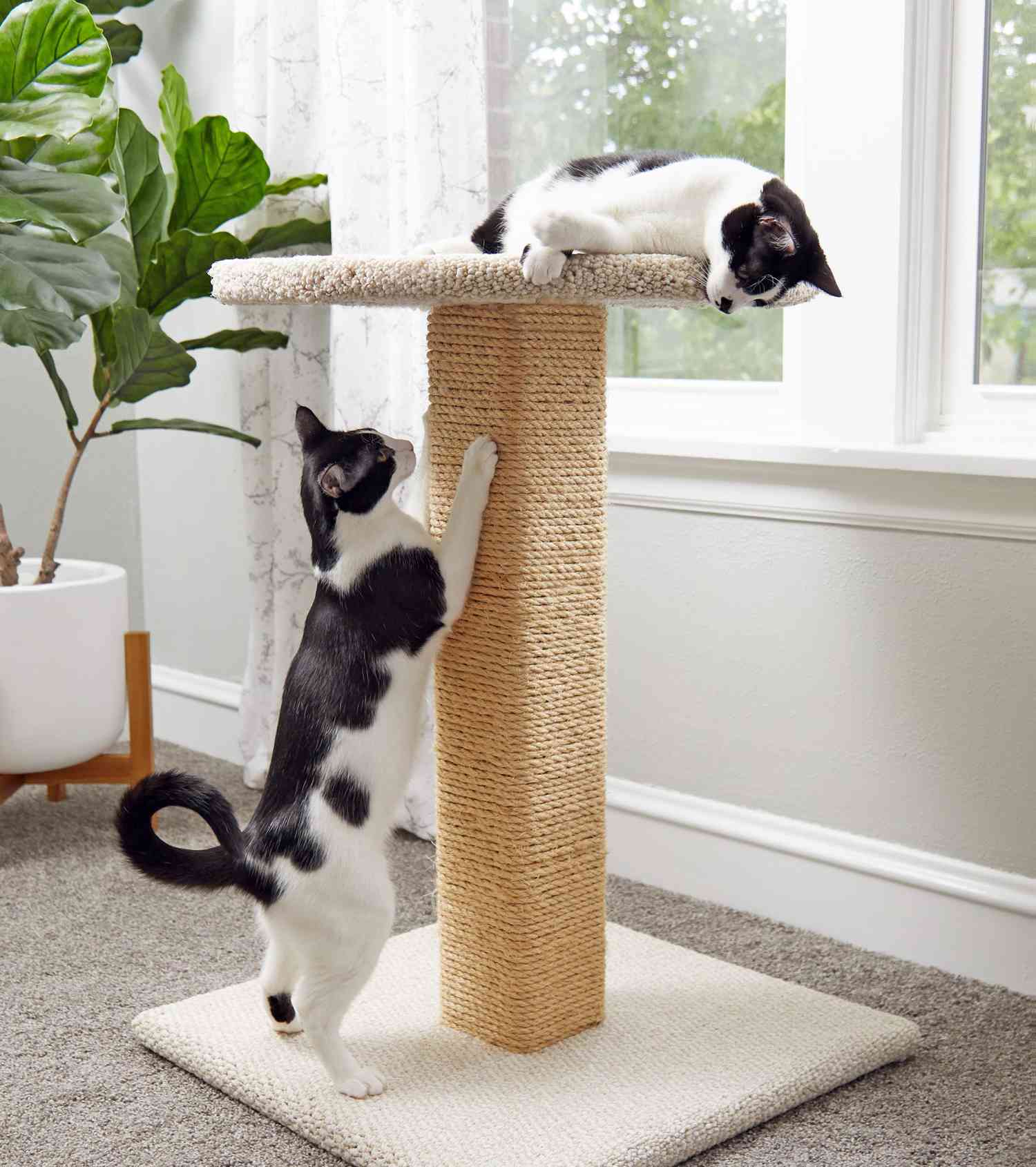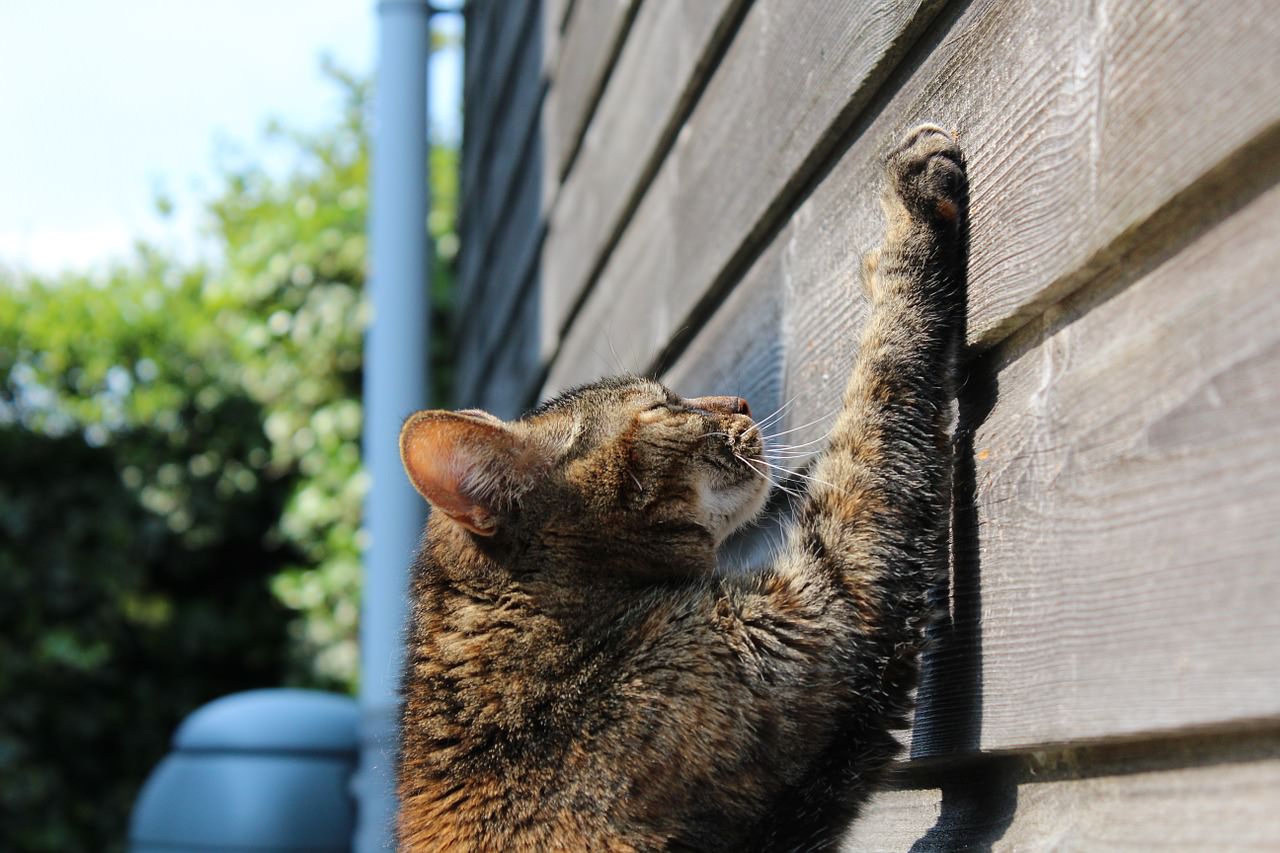A scratching post is an excellent place for all cats, from kittens to giant felines. Scratching poles are often built with multiple levels connected by regular sisal columns 3-7 cm thick and are incredibly resistant to cat claws.
The individual stations have caves and recesses, which offer cats enough space to hide and sleep.

Why is a cat scratcher so essential?
The household cat is a predator by nature. It can move fast, climb trees, and grab prey like its wild counterparts. Her claws are an essential tool that requires careful care.
Some owners indulge in one of the most inhumane ways of dealing with this issue, by completely removing the claws of their pet – entirely incapacitating it. This is akin to cutting off their finger.
The claw is a sensitive instrument with a constantly renewed surface. Much like our nails, it continually grows, and the stratum corneum has to be shed by the feline. Nature provided it with tree barks for this purpose, however, they’re deprived of a natural solution when domesticated.
While indulging in the above, the cat’s fingers release fragrant scents that act as trace markers for their companions.
How does a cat scratching post need to be?
The primary condition for a place to sharpen cat claws is durability and stability. The surface should be hard enough to easily peel off the stratum corneum, but not damage the feet.
The surface of the scratcher should be fibrous and rough with torn fibers. Otherwise, the pet risks getting hung on the post, possibly even entangled in it.
You can imagine that the best for this job are natural materials: wood, hemp, sack, coarse woolen fabric, and thick cardboard.
One cannot use most synthetic fibrous materials, as they come with highly resilient and way too strong fibers – so strong, in fact, that they can pull out the claw entirely.

Why is sisal good for a cat scratching post?
In the wild, cats have sharp nails on the trees because they are firm, stable, and have good resistance. Opt for a scratcher that will provide the cat with the same conditions.
Sisal is a trendy material in making cat scratchers because it is strong, durable, and tears under cats’ claws exceptionally comfortably.
Scratchers wrapped in fabric or sisal rope are generally the best scratchers for cats.
It is wise to avoid scratches made from materials in your home. For example, carpet scratchers can motivate your cat to sharpen its claws on your living room rug.
So, if you enjoy making original pieces of furniture, making a scratcher is a way to delight your pet.
What to look for when making a scratcher
Please pay attention to statics: the higher the claw sharpening pole, the more stable it must be. Make sure the stand is heavy enough, and if necessary, attach the trunk to the ceiling or wall.
Use only harmless materials for your pet’s health—especially when dealing with paints and adhesives.
Look for materials that do not contain dangerous chemicals if you wish to wrap the trunk in sisal rope or cover the resting places with a cloth.
Avoid anything that could injure your cat – staples, protruding nails and screws, and wood chips.
Remember to sand all slabs and columns thoroughly. Ensure you tie the rope tight.
Measure the exact spot where your cat should sharpen its claws later, so you can get in a new rope or a wrapping surface later.
Ensure the project has sufficient space for the cat to sit around the post.
There should be sufficient space to jump on the floor. Make a detailed sketch beforehand to know what material you need.

Scratching post making Instructions
The taller the scratching post, the better! (Make it a proper cat tree)
The first step is to construct a vertical column to wrap the sisal around.
What you need – Plywood 45 × 45 cm, wood screws, screwdriver, drill plywood column width 10 × 10 cm, length arbitrary, sisal rope, glue.
You need a plywood base of 45 × 45 cm. It can be of arbitrary dimensions. It would help if you had a thicker piece of plywood for the pole, say 10 × 10 cm.
Determine the length of the scratch post yourself. It depends on the habit and requirements of your kitten.
If the cats are larger and like to stretch a lot, it is best to be a little longer. (Again, a proper cat tree)
Sand everything well so that there are no sharp edges.
You can also paint or repaint however you want. Screw the pillar for the base, i.e., the plywood base.
Wrap the sisal rope around the post by gluing it around the center, gluing it piece by piece. Scratch post is done!
What to do when a cat destroys a sisal scratcher and how to repair it?
Brushing cats’ nails is a natural behavior and are essential to them for several reasons. In addition to nail care, cats thus stretch (this is their exercise) and communicate.
Scratches (a visual message) and the smell they leave from the glands between the fingers (an olfactory, i.e., olfactory message) are for communication.

Scratching is normal behavior for a cat!
Unfortunately, some owners consider sanding nails a problem due to damage to furniture, doors, walls, etc.
Punishing cats for buffing their nails isn’t humane. A cat punished by the owner will get scared and sharpen its nails in places where the owner does not see it or when it is not at home.
If we want domestic cats to not grind their nails on furniture, door stocks, carpet, or wall with wallpaper, it is necessary to provide cats with a suitable scratcher to grind their nails.
Every owner should observe their cat and see what suits her best.
The cat can destroy the sharpening stand because of this need for constant claw sharpening.
Sisal is a resistant material, but it is not indestructible, especially if we consider that the cat spends hours and hours scratching it.
The glue may loosen, and the sisal unwinds, breaks, or destroys.
Here’s how to help yourself and your pet in a few simple steps:
- The first thing is to discard the old sisal and replace it with a new one. You can purchase sisal in various shopping malls that sell home decorating equipment or carpet malls. You will also need glue and scissors.
You can use hot glue or wood fix – it’s up to you to decide. The difference is that the wood fix takes longer to dry, but the scratcher is ready for the second day. If you opt for hot glue – get a whole pack of cartridges because many of them dry quickly. - Unwrap and discard the old sisal. Then remove all traces of glue.
- Unroll and glue the sisal on the scratcher
- Just cut the sisal rope and glue it securely until you reach the end.
- Wait for the hot glue to dry/cool. That’s it. You have a straightened scratcher once again.




